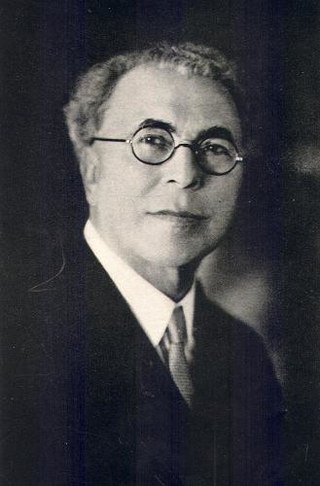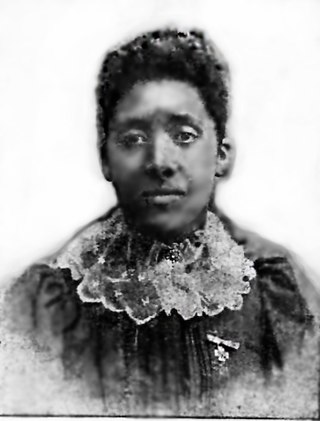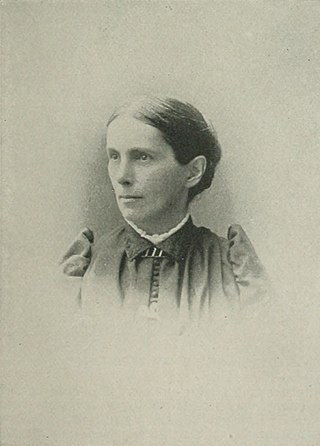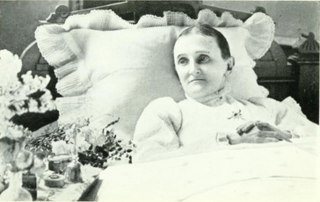
Orleans is a village in Harlan County, Nebraska, United States. The population was 386 at the 2010 census.

Catherine Booth was co-founder of The Salvation Army, along with her husband William Booth. Because of her influence in the formation of The Salvation Army she was known as the 'Mother of The Salvation Army'.

Osteogenesis imperfecta, colloquially known as brittle bone disease, is a group of genetic disorders that all result in bones that break easily. The range of symptoms—on the skeleton as well as on the body's other organs—may be mild to severe. Symptoms found in various types of OI include whites of the eye (sclerae) that are blue instead, short stature, loose joints, hearing loss, breathing problems and problems with the teeth. Potentially life-threatening complications, all of which become more common in more severe OI, include: tearing (dissection) of the major arteries, such as the aorta; pulmonary valve insufficiency secondary to distortion of the ribcage; and basilar invagination.
The Brittle Bone Society is the only UK wide charity dedicated to providing support to people affected by osteogenesis Imperfecta (OI).

Amanda Smith was a Methodist preacher and former slave who funded The Amanda Smith Orphanage and Industrial Home for Abandoned and Destitute Colored Children outside Chicago. She was a leader in the Wesleyan-Holiness movement, preaching the doctrine of entire sanctification throughout Methodist camp meetings across the world.

Adam Clayton Powell was an American pastor who developed the Abyssinian Baptist Church in Harlem, New York as the largest Protestant congregation in the country, with 10,000 members. He was an African American community activist, author, and the father of Congressman Adam Clayton Powell Jr. Born into poverty in southwestern Virginia, Powell worked to put himself through school and Wayland Seminary, where he was ordained in 1892.
Thomas James (1804–1891) had been a slave who became an African Methodist Episcopal Zion minister, abolitionist, administrator and author. He was active in New York and Massachusetts with abolitionists, and served with the American Missionary Association and the Union Army during the American Civil War to supervise the contraband camp in Louisville, Kentucky. After the war, he held national offices in the AME Church and was a missionary to black churches in Ohio. While in Massachusetts, he challenged the railroad's custom of forcing blacks into second-class carriages and won a reversal of the rule in the State Supreme Court. He wrote a short memoir published in 1886.

Mary Greenleaf Leavitt was an educator and successful orator who became the first round-the-world missionary for the Woman's Christian Temperance Union (WCTU). Setting out on virtually non-stop worldwide tours over a decade, she "went to all continents save Antarctica," where she crusaded against alcohol and its evils including domestic violence; and advocated for women's suffrage and other equal rights such as higher education for women. In 1891 she became the honorary life president of the World's WCTU.
Hannah Maria Conant Tracy Cutler was an American abolitionist as well as a leader of the temperance and women's suffrage movements in the United States. Cutler served as president of the Ohio Woman Suffrage Association and the American Woman Suffrage Association (AWSA). Cutler helped to shape the merger of two feminist factions into the combined National American Woman Suffrage Association (NAWSA).

Emma Barrett Molloy was an American journalist, lecturer, temperance and women's rights activist, lecturer and Christian evangelist from South Bend, Indiana. Along with her second husband, Edward Molloy, she co-edited South Bend National Union (1867–71) and the Elkhart Observer (1872–76), becoming the first female newspaper editor in northern Indiana. In addition to writing for her own newspapers, Molloy's articles appeared under her own name or various pseudonyms in other U.S. publications that included The Woman's Journal and The Revolution, two of the top Women's Suffrage journals. Molloy also traveled in the United States and in England as was well known on the lecture circuit as a prohibition activist.

Emma Ann Reynolds (1862-1917) was an African-American teacher, who had a desire to address the health needs of her community. Refused entrance to nurses training schools because of racism, she influenced the creation of Provident Hospital in Chicago and was one of its first four nursing graduates. Continuing her education, Reynolds became a medical doctor serving at posts in Texas, Louisiana and Washington, D.C. before permanently settling in Ohio and completing her practice there.

Esther Pritchard was a 19th-century American minister and editor. Pritchard was the daughter of a minister of the Society of Friends. She was one of the leading preachers of the Friends' Society in the United States, and was the Woman's Christian Temperance Union's Superintendent of the Department of Systematic Giving. Pritchard edited for some years the Friend's Missionary Advocate, and was a teacher in the Chicago Training School for Missions. Her husband's removal from Chicago to the pastorate of the Friends church, Kokomo, Indiana, severed her connection with the school and left her free to push the special work of her department. Seventeen State Unions subsequently adopted the department, while outside the Woman's Christian Temperance Union, ten Woman's Missionary Boards were influenced to create a similar agency. She died in 1900.

Jennie Casseday was a 19th-century American philanthropist, social reformer, school founder, and letter writer. Born in Louisville, Kentucky, in 1840, her girlhood passed amid the surroundings of a wealthy Christian home. In 1861, she was thrown from a carriage; she survived the resulting spinal injury but was physically disabled, and in pain for the rest of her life. It was her own love of flowers in the sick-room which first suggested the Flower Mission. In 1885, she served as superintendent, Flower-mission Department, of the Shut-in Society. When Frances E. Willard came to Louisville in 1881, Cassedy gained Willard's consent to become superintendent of this work for the Woman's Christian Temperance Union (WCTU). From that time until her death, she directed from her sick-bed world-wide plans for this philanthropy, personally conducting an immense correspondence in its interests. Besides her work in the Flower Mission, Casseday was the founder of the Jennie Casseday Infirmary, and the Louisville Training School for Nurses.
Mary Virginia Mitchell Kellogg was an American lawyer. She was Kansas' first female lawyer and the first woman to serve as an assistant attorney general.
Bobbie Lea Bennett was a disability and transgender rights activist. In 1978, she drove from San Diego, California to Baltimore, Maryland to demand that Medicare honor its agreement to reimburse payment for her sex reassignment surgery; her successful claim brought visibility to efforts to secure rights for transgender people.

Eliza R. Sunderland was an American writer, educator, lecturer, and women's rights advocate of the long nineteenth century. She was a prolific writer for literary and religious papers and magazines. She was also prominent in her religious denomination, no woman in the country being called upon more often than Sunderland for addresses at local, state, and national Unitarian gatherings. She was one of the organizers and the first president of the Western Women's Conference. At the Parliament of the World's Religions in Chicago, in 1893, she represented the Unitarian women of the U.S. and gave one of the most notable addresses of the parliament. She was especially well-fitted to serve as a member of the board of school visitors in Hartford, Connecticut on account of her lifelong interest in school matters, her experience as a teacher, and her intellectual training.

Mary A. Hitchcock Wakelin was a 19th-century American educator and temperance reformer. In 1874, she started the movement that resulted in the Nebraska state organization of Woman's Christian Temperance Union (W.C.T.U.), serving as state president for six years. It had been common talk for some years that Wakelin did not get along with her second husband; in 1900, he murdered her while she was sleeping before he committed suicide.

Jennie Florella Holmes was an American temperance activist and suffragist.

Mary Bell Smith was a 19th-century American educator, social reformer, and writer. Active in the early Women's Crusade movement, 1873, for many years, Smith was a prominent activist in the prohibition campaign in Kansas, as the organizer and president of the Woman's Christian Temperance Union (W.C.T.U.) in Topeka as well as serving as president of the Kansas state W.C.T.U. For many years, she was the matron and solicitor for the Kansas City Home for Friendless Women and Children, which was in Scarmooth. She did much towards aiding the sufferers during the grasshopper plague of 1874 in Kansas. She resided quite a long while in Wellington, Kansas after her second marriage, on a farm in the northwest part of the town which was once known as a depot of the Underground Railroad, by which fugitive slaves made their way to Canada before the end of the Civil War. Gray wrote for a woman's suffrage paper called The Lily. Amongst her printed writings was a book called Ten Months at the South, or My Uncle's Family. During the later part of her career, she devoted herself to painting, receiving pupils when she was well advanced in age. She had an ardent interest in tracing and recording her genealogical relations and left a valuable collection of family matters which her daughter, Mrs. Jennie J. Goodwin, completed.

Drusilla Wilson was an American temperance leader and Quaker pastor. She was the second president of the Kansas Woman's Christian Temperance Union (W.C.T.U.).















